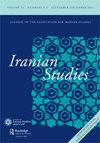从仪式到表演:今天伊朗的塔齐耶
IF 0.9
4区 社会学
Q2 AREA STUDIES
引用次数: 0
摘要
作为一种实践和体验,打子戏处于仪式与表演、集体悲叹与回忆、文学与民俗的十字路口。本文以观众的体验为中心,探讨了ta’zieh在当今伊朗的有限地位和多种功能。本研究基于2017年秋季在德黑兰(大巴扎)、伊斯法罕(Falāvarjān)和卡尚(Nushābād)实地调查期间收集的观察结果。通过比较,我们进一步思考Abbas Kiarostami于2003年在巴黎蓬皮杜艺术中心(Centre Georges Pompidou)展出的一件录像装置,它挑战了人们对塔齐耶的审美和宗教效果的普遍假设。这种对比使我们能够阐明,当代伊朗表演艺术如何通过翻新古老的叙事形式,参与塑造个人情感和公共情感。本文章由计算机程序翻译,如有差异,请以英文原文为准。
From ritual to performance: Ta'zieh in Iran today
Abstract As a practice and experience, ta'zieh lies at the crossroads between ritual and performance, collective lament and recollection, literature, and folklore. Focusing on the experience of the spectator, this paper discusses ta'zieh's liminal status and diverse functions in Iran today. This study is based on observations gathered during fieldwork in the fall of 2017 in Tehran (Grand Bazaar), Isfahan (Falāvarjān), and Kashan (Nushābād). By way of comparison, we further reflect on a video installation by Abbas Kiarostami presented at the Centre Georges Pompidou in Paris in 2003, which challenges common assumptions about the aesthetic and religious effectiveness of ta'zieh. The contrast allows us to elucidate how, by renovating ancient narrative forms, contemporary Iranian performing arts partake in the shaping of individual affects as well as communal emotions.
求助全文
通过发布文献求助,成功后即可免费获取论文全文。
去求助
来源期刊

Iranian Studies
Multiple-
自引率
0.00%
发文量
92
期刊介绍:
Iranian Studies is a peer-reviewed journal devoted to Iranian and Persian history, literature, and society, published on behalf of the Association for Iranian Studies . Its scope includes all areas of the world with a Persian or Iranian legacy, especially Iran, Afghanistan, Central Asia and the Caucasus, and northern India, and Iranians in the diaspora. It welcomes submissions in all disciplines.
 求助内容:
求助内容: 应助结果提醒方式:
应助结果提醒方式:


